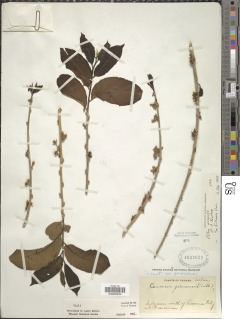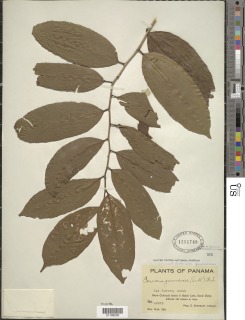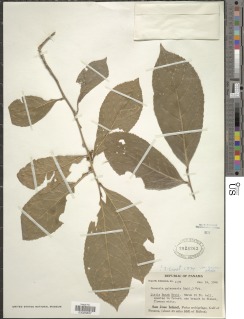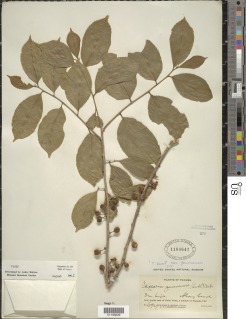

|
|
|
|
Family: Flacourtiaceae
Guyanese Wild Coffee, more... (es: coloraito, palo de la cruz)
|
Description: A shrub or treelet, no more than 6 m tall. Leaves are toothed, simple, alternate, and arranged in a flat plane, regularly-spaced along the branches. Holding the leaf up to light reveals tiny, light dots or streaks; they are not conspicuous, and are only clearly seen using a hand lens and holding the leaf toward very bright sky, or in front of a flashlight. Stipules are white but readily fall off. Reproduction: Flowers are produced from March to May, singly or in small groups along the the branches; they are white, about 1-2 cm across. The fruits mature in May and June as green capsules with three valves that open, revealing small seeds with red aril. Birds are attracted by the aril. Distribution: Found most often in secondary forests of the Pacific slope, where it can be fairly common. Seen along roads in Gamboa and south toward Panama City. Uncommon at Barro Colorado and Soberania, and not see on the Caribbean slope. Similar Species: Toothed alternate leaves in a regular, flat plane, are characteristic of several species in the family Flacourtiaceae. Most also have transparent dots in the leaves, but these can be hard to see. LK casea1 Casearia arguta LK2 is particularly similar; note the leaf undersides. See also LK caseco Casearia commersoniana LK2 and LK casear Casearia arborea. LK2 A common shrub with toothed leaves and white stipules is LK hybapr Hybanthus prunifolius, LK2 but its leaves are smaller and arranged differently. Descripción: Árbol de 3 a 6 m de alto. Tronco y ramas con lenticelas blancas. Hojas simples y alternas, de 5-18 x 3-8 cm, obovadas, con ápice acuminado, bordes aserrados o dentados y base decurrente. Las hojas presentan puntos y rayas translúcidas. Estípulas triangulares blancas y pequeñas. Pecíolo de 0.2-1 cm de largo y ligeramente acanalados en la parte superior. Flores blancas y aromáticas, agrupadas en fascículos axilares. Frutos en cápsulas, de 0.8-1.5 cm de largo, verdes, tornándose blancos y dehiscentes al madurar. Semillas con sarcotesta anaranjada. Datos Ecológicos: La especie crece a bajas elevaciones, en bosques secos o húmedos. En Panamá se encuentra en las provincias de Bocas del Toro, Colón, Darién, Herrera, Panamá y Veraguas. Deja caer sus hojas durante la estación seca, pero las repone a inicios de la estación lluviosa. Florece y fructifica de marzo a junio. Las flores son visitadas por abejas y otros insectos. Especies Parecidas: A menudo se confunde con LK hybapr Hybanthus prunifolius LK2 , pero en H. prunifolius las flores y los frutos son de mayor tamaño y las semillas no tienen sarcotesta anaranjada. También se puede confundir con LK xyl2ol Xylosma oligandra LK2 , pero X. oligandra tiene espinas en el tronco y las ramas. Usos: La madera es empleada en la construcción de viviendas rurales, leña y para la fabricación de mangos de herramientas. También para pulpa de papel, formaletas y postes de cercas. Shrub or small tree, (1.5) 3-6 (10) m tall; trunk to 12 cm dbh; stems glabrous to puberulent. Leaves deciduous; stipules subulate, 2-5 mm long, densely pubescent, caducous; petioles 2-10 mm long; blades mostly obovate, abruptly acuminate, acute and +/- decurrent at base, 5-18 cm. long, 2-8.5 cm wide, glabrous or puberulent on veins especially below, pellucid-punctate and pellucid-lineate, +/- entire to shallowly crenate-serrate, the teeth often sharp. Fascicles dense, in old leaf axils; pedicels and calyx puberulent; pedicels 2.7-4.7 mm. long at anthesis, articulated shortly above base, elongating to 8 mm in fruit; flowers white, with a faint sweet aroma, precocious; calyx deeply 4-6-lobed, 4-6 mm long, the lobes spreading; corolla lacking; stamens (7) 8, +/- glabrous, 2.5-3.5 mm long, alternating and uniting with much shorter, densely villous staminodia; ovary villous; stigma globular, held +/- at level of anthers. Capsules ellipsoid, 8-14 mm long, green often becoming violet-purple at least at apex, splitting into 3 parts; valves red inside; seeds several, irregular, brown, ca 3 mm long, enveloped in an orange aril. Croat 8391, 8747. Common along the shore and at the margins of clearings; occasional in the young forest. Flowers commonly from March to May. The fruits mature from March through June. Leaves fall before flowering, and new leaves begin to develop near the time of flowering in the late dry season. |
|
|
|

































